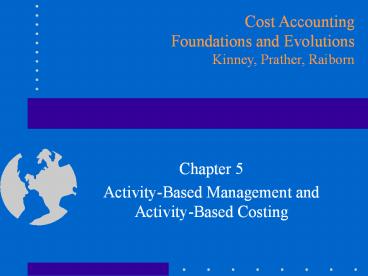Activity-Based Management and Activity-Based Costing - PowerPoint PPT Presentation
Title:
Activity-Based Management and Activity-Based Costing
Description:
Cost Accounting Foundations and Evolutions Kinney, Prather, Raiborn Chapter 5 Activity-Based Management and Activity-Based Costing Activity An activity is a ... – PowerPoint PPT presentation
Number of Views:231
Avg rating:3.0/5.0
Title: Activity-Based Management and Activity-Based Costing
1
Cost Accounting Foundations and
Evolutions Kinney, Prather, Raiborn
Chapter 5 Activity-Based Management and
Activity-Based Costing
2
Learning Objectives (1 of 2)
- Identify the focus of activity-based management
- Explain why non-value-added activities cause
costs to increase unnecessarily - Explain why cost drivers are designated in
activity-based costing
3
Learning Objectives (2 of 2)
- Contrast activity-based costing to the
traditional cost accounting system - Describe the types of information provided by an
activity-based costing/management system - Explain when it is appropriate to use
activity-based costing
4
Activity-Based Management
- Focuses on activities during production and
performance process - Improves the value received by customers
- Enhances profitability
5
Activity
- An activity is a repetitive action performed in
fulfillment of a business function
6
Activity-Based Management
Operational control Quality management Business
process improvement Performance measurement
Activity analysis Cost driver analysis Activity-ba
sed costing Continuous improvement
7
Activity Based Management
- External Benefits
- Increased customer value
- Enhanced profitability
- Internal Benefits
- More efficient production
- More accurate cost determination
- More effective performance evaluation
8
Activity Analysis
- Non-value-added activity
- Increases time spent on product or service but
does not increase worth - Unnecessary from customer perspective
- Can be reduced, redesigned or eliminated without
affecting market value or quality - Business-value-added activities are essential
- Value-added activity
- Increases worth of product or service to a
customer - Customer is willing to pay for it
9
Cost Driver Analysis
- Cost drivers are factors that have a direct
cause-effect relationship to a cost - Limit the number of cost drivers
- Cost of measurement should not exceed benefit of
using the cost driver - Easy to understand
- Directly related to activity being performed
- Appropriate for measurement
10
Cost Driver Analysis
- Unit-level costs
- direct material, direct labor
- Batch-level costs
- setup, inspection
- Product/process-level costs
- engineering changes, product development
- Organizational or facility costs
- building depreciation, plant managers salary
11
Activity-Based Costing
- Recognizes several levels of costs
- Accumulates costs into related cost pools
- Uses multiple cost drivers to assign costs to
products and services
12
Two-Step Allocation
- Collect costs in general ledger and subsidiary
accounts - Identify activity centers
- Accumulate costs into activity center cost pools
cost drivers - Allocate costs to products and services
- activity driver measures demands placed on
activities, thus, the resources consumed by
products/services
13
Traditional vs. ABC Costing
- When ABC implemented
- Cost reduced for high volume, standard products
- Cost increased for low-volume, complex specialty
products
14
Use ABC Costing when.
- Product Variety and Process Complexity
- Caused by mass customization
- Too many choices, opportunity for errors
- Pareto Principle
- Commonality of parts
- Reduced by
- Simultaneous (or Concurrent) Engineering
- Design for Manufacturability
15
Use ABC Costing when.
- Lack of Commonality in Overhead Costs
- - Some products/services use substantially
more overhead than others - Problems with Current Cost Allocations
- - Significant changes in process with no
change in cost allocations - - Expense majority of period costs when
incurred
16
Use ABC Costing when.
- Changes in Business Environment
- Increase in competition
- Change in management strategy
17
Continuous Improvement
- Eliminates non-value-added activities to reduce
cycle time - Makes products/performs services with zero
defects - Reduces product costs on an ongoing basis
- Simplifies products and processes
ABC Costing Supports Continuous Improvement
18
Criticisms of ABC
- Significant amount of time and cost to implement
- Must overcome barriers to change
- Does not conform to GAAP
- May not promote total quality management
19
Advantages of ABC and ABM
- Identify and monitor significant technology costs
- Trace technology costs directly to products
- Identify the cost drivers that create or
influence cost - Identify activities that do not contribute to
perceived customer value
20
Advantages of ABC and ABM
- Illustrate the impact of new technologies on all
elements of performance - Translate company goals into activity goals
- Analyze the performance of activities across
business functions - Analyze performance problems
- Promote standards of excellence
21
Questions
- What are the differences between activity-based
costing and traditional cost accounting? - What are cost drivers and activity drivers?
- What are two advantages and two criticisms of
activity-based costing?































